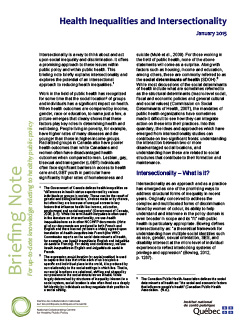Health Inequalities and Intersectionality
Intersectionality is a way to think about and act upon social inequality and discrimination. It offers a promising approach to these issues within public policy and within public health. This briefing note briefly explains intersectionality and explores the potential of an intersectional approach to reducing health inequalities.1
Work in the field of public health has recognized for some time that the social location2 of groups and individuals has a significant impact on health. When health outcomes are compared by income, gender, race or education, to name just a few, a picture emerges that clearly shows that these factors play key roles in determining health and well-being. People living in poverty, for example, have higher rates of many diseases and die younger than those in higher-income groups. Racialized groups in Canada also have poorer health outcomes than white Canadians and women often have disadvantaged health outcomes when compared to men. Lesbian, gay, bisexual and transgender (LGBT) individuals often face significant barriers in access to health care and LGBT youth in particular have significantly higher rates of homelessness and suicide (Mulé et al., 2009).
Reducing health inequalities has become a focus of public health in recent years, both in the literature and in practice. These inequalities are related to broader social inequalities that are felt at every level of Canadian society. While some gains have been made over several decades, there is still a need to focus on the best ways to approach inequality. Intersectionality is an approach which draws our attention to the ways that social locations interact to produce advantage and disadvantage for groups and for individuals. It also helps us to consider how these positions interact with, and constituted by, social policy and social structures. Carrying this work forward in public health will add to our critical understanding of social inequalities in particular, as well as give us some help in addressing them.
- The Government of Canada defines health inequalities as “differences in health status experienced by various individuals or groups in society. These can be the result of genetic and biological factors, choices made or by chance, but often they are because of unequal access to key factors that influence health like income, education, employment and social supports” (Government of Canada, 2008, p. 5).
- The expression social location (or social position) is used to capture the idea that while each of us occupies a specific and individual place in the world, it is produced by our relationship to the social settings in which live. That is, our social locations are relational, shifting and shaped by our positions in the social structures we inhabit. While largely determined by structures of inequality inherent in a social system, social location is also often lived as a deeply felt identity by individuals as they negotiate their position in a social setting.


